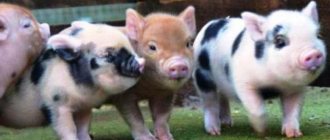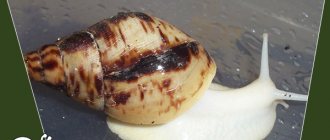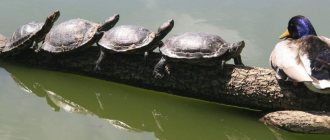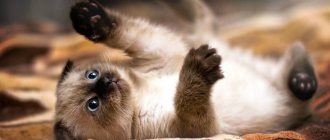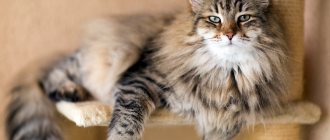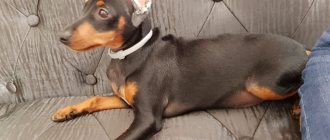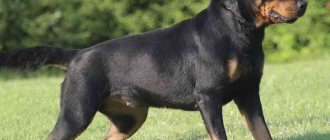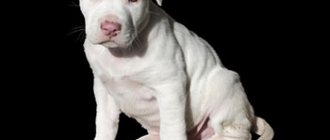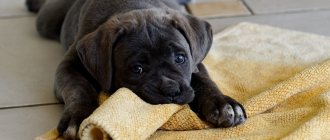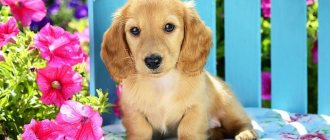- Dog breeds
The Miniature Pinscher breed was originally bred in Germany to hunt rats in houses and stables. Many people think that the Miniature Pinscher was created by breeding Dobermans to gradually smaller sizes, and indeed, the Miniature Pinscher looks similar to the Doberman. However, the miniature pinscher is a separate and much older breed of dog.
- Country of origin : Germany
- Height at withers : male: 25–30 cm, female: 25–28 cm
- Weight : male: 4–5 kg, female: 3.5–4 kg
- Lifespan : 13-15 years
- Use : companion dog, rat catcher
- Other names : miniature pinscher, miniature pinscher
History of the breed
The Miniature Pinscher is believed to be an ancient breed of dog, but can only be reliably traced back a few hundred years. It was developed in Germany to kill rats in houses and stables.
There it was first named the Reh Pinscher because of its supposed resemblance to the Reh, or small deer, which formerly lived in the forests of Germany. The development of the Miniature Pinscher began in 1895, when German breeders created the Pinscher Club, later renamed the Schnauzer Pinscher Club. It was then that the first breed standard was written. Miniature Pinschers were first shown at the Stuttgart Dog Show in Germany in 1900.
From 1905 until World War I, the Miniature Pinscher quickly gained popularity in Germany. After World War I, breeders in Germany, as well as in the Scandinavian countries, worked to improve the line.
Miniature Pinscher: breed features
- Hardy, but very small dogs that can be easily injured by rough handling. Because of this, they are better suited as pets for older children.
- Sensitive to cold. Don't forget to put a sweater on him when you take him outside during very cold seasons.
- Since they were originally bred to hunt rats, they can attack small objects (such as bottle caps), which can be dangerous and injure the pet. He may also chase small pets, which he perceives as prey. So don't let him off the leash.
- Very active and curious. You must constantly monitor him.
- You must be willing to take a leadership position. If you don't do this, he will happily take on this role.
Feeding the miniature pinscher
All owners wonder what to feed their miniature pinscher. Natural feeding is preferable for these dogs.
A balanced diet should include the following foods:
- beef (any red meat is suitable, including horse meat);
- a mixture of vegetables (zucchini, cucumber, pepper, pumpkin, carrots);
- dairy products (sour cream, cottage cheese);
- porridge (rice, wheat, buckwheat);
- seafood;
- articular bones in raw form;
- berries (you can give everything except grapes).
It is very important to monitor the condition of your pet and not overfeed it. The Pinscher loves to eat, and owners often spoil their pets by offering them too much food.
Care and maintenance
- Not demanding in care.
- Bath as needed.
- Clean your ears every three days.
- Clean your eyes as mucous discharge occurs.
- Dental care. It is enough to examine the teeth and oral cavity of a miniature pinscher once a week. As for the care itself, during a thorough examination you should pay attention to: The condition of the gums - if they are red and inflamed, it is recommended to contact a veterinarian who will recommend special medications or remedies;
- Teeth color – ideally, it should remain normal, without plaque (you can clean it yourself) and purulent formations. To maintain teeth in good condition, special bones and toothpastes for dogs can be very useful;
- Dental health – check for loose or broken teeth. Between them there should also be no food residues, the accumulation of which causes the animal to develop an unpleasant odor from the mouth and subsequently rot;
- The presence of tartar - in this case, it is impossible to do without the intervention of a veterinarian and its removal. It should also be noted that an important factor for the health of the miniature pinscher - and in particular the teeth - is proper balanced nutrition.
Remember that all dog grooming procedures help to establish a relationship with the dog and train him to be disciplined. Regular checking of your miniature pinscher puppy will develop into a kind of obligatory and pleasant communication procedure. If you notice any changes in behavior or find any unexplained sores or redness, contact your veterinarian.
General information
Miniature Pinscher: description of the breed and character
The breed standard is prescribed in the classification of the Federation Cynologique Internationale (FCI) and includes the following parameters:
- Height. 25 to 30 cm is preferred. Miniature pinschers 30-40 cm tall are classified as medium rather than dwarf.
- Weight. It ranges from 4 to 6 kg for an adult dog. Depends on gender and physical development.
- Lifespan. Up to 20 years old.
- Head. Proportional to the body. Elongated muzzle, flat forehead. Black nose. Brown or black oval-shaped eyes. Powerful chewing jaws.
- Ears. Set high, triangular in shape. When excited, the ears become larger. Previously, ears were cropped without fail. Currently, deviations from this norm are allowed.
- Neck. Elongated, graceful, set high. There are no folds.
- Limbs. Strong, smooth, stable, with well-developed muscles. The hind legs are always longer than the front legs.
- The body is sculpted and muscular. The chest is square. The croup is shortened. The belly line is tucked up, making these dogs look very slender.
- The tail is set high, without kinks. The tail is docked to 12-20 mm, but is often left in its natural shape.
- The coat is short, hard, shiny. Emphasizes the outline and athleticism of the dog.
- The color, according to the standard, can be one-color or two-color. The monochromatic color includes all shades of brown: from brown-red to mustard yellow. Bicolor is typically black and tan with tan markings on the feet, chest (there should be two tan triangles), above the eyes, on the inner thighs and under the tail.
Interesting. In the past, the brown and tan color stood out. It has now been removed from the breed standard due to its rarity. Now pinschers of this color are bred only in the USA.
The character of the miniature pinscher is quite complex. But with proper upbringing and training, all negative aspects can be avoided.
Pros of the breed. With proper upbringing and care, miniature pinschers are inquisitive and study the world around them with interest. They are active, calm, and smart. They love to discover and learn new things. They are cheerful. They move a lot and actively, and they like to grab various objects. Thanks to their energy, they love to play and become children's best friends.
At the same time, miniature pinschers are strong-willed dogs. They are demanding in maintaining personal boundaries and protecting their owner. Despite their small size, miniature pinschers are excellent watchdogs and can cope with small rodents and other pests.
Disadvantages of the breed. The negative aspects of the miniature pinscher include, first of all, its stubborn character and desire to constantly dominate. He's jealous. If he is left alone for a long time, he may express his protest and dissatisfaction with damage to the owner’s property: for example, chew furniture, shoes or other things. Out of jealousy, a dog may even shit in the house. Unfriendly with other animals. The exception will be the pets with whom he grew up.
On a note. To avoid troubles in the house while the owner is away, dog experts recommend equipping a special cage or playpen for the pet. Many dogs subsequently perceive such cages as their personal territory and willingly spend time in them.
Health
- progressive retinal atrophy;
- Perthes disease;
- epilepsy;
- hypothyroidism;
- congenital or acquired dislocation of the kneecap.
Preventive measures to protect your miniature pinscher puppy
- To keep your miniature pinscher puppy completely safe, you first need to minimize his contact with unfamiliar dogs, especially strays. Therefore, you should not let your dog off the leash, as in this case it will become impossible to control its behavior and communication with other dogs. Since a dog can easily become infected with distemper from simply touching the nose of a sick animal. This disease can be transmitted to a dog through sniffing. Your dog can become infected with trichophytosis from contact with the lichen-affected fur of a sick dog. Naturally, it is impossible to completely exclude a dog’s communication with other dogs, since it must be socialized. Therefore, try to find friends with dog lovers who look after their animals. By adhering to this rule, you can eliminate the risk of pathogen transmission by 80%.
- You should walk your dog in places where there are no landfills. Since garbage very often attracts rodents, which in turn are very often carriers of various infections. Gray rats are especially dangerous because they carry such a serious disease as leptospirosis.
- You should not allow your dog to sniff other people's feces, as they are a source of worms.
- Monitor the health of your Miniature Pinscher. Pay attention to even the most minor changes in his behavior. For example, your dog may appear lethargic, lose his appetite, or have a dry nose. Or you may notice that the dog begins to shed, and this has nothing to do with seasonal shedding. If hair loss becomes excessive, this is the first symptom indicating health problems in your pet. And only you can help him. Therefore, it is important to take the dog to the veterinary clinic in time, where the disease can be overcome for sure. In no case should you ignore the symptoms, since advanced infections are much more difficult to treat, and sometimes even impossible. If you start treating your dog, the disease can lead to his death or he will develop serious complications that will affect his hearing, vision, limbs and much more.
Rules for choosing puppies
In order to buy a healthy pet, you need:
- Have a complete understanding of the place where you plan to buy a dog. It is important to find reviews about the nursery and breeder. Familiarize yourself with the documents that must be provided by the breeder himself.
- Find out the story. Look at your parents. Ask about their genetic diseases and possible predisposition in the puppy.
- Observe the baby in the pack. Among other relatives, the pinscher manifests itself as a leader or hides in the corner. Each owner selects a pet to suit his own character.
- Study the dog's appearance. For example, irregularities in a dog's coat indicate a weakened immune system.
- Take a dog handler with you. Then no error will occur.
Training and education
Dogs are highly trainable, but will require much more time than most other breeds. The training method should be based on the principles of consistency and repetition.
Submitting a dog doesn't always work. The principle of complete submission of the miniature pinscher to the owner is an outdated method. This theory was formulated based on observations of packs of wild wolves, but they were kept in captivity and, of course, experienced stress. The stress condition forced wolves to show aggression towards each other, but in the wild they do not show aggression to each other - they live together and interact with each other. You need to perceive yourself as the more experienced and mature member of the pack, who is responsible for guiding the new member (miniature pinscher puppy) and teaching him good behavior, as well as correcting him if necessary. It is important to remember that Miniature Pinscher puppies learn a lot on their own. They are very inquisitive, love to explore new territories and, of course, experiment. Puppies tend to repeat actions they enjoy (like playing with a toy). They do not repeat actions that cause them pain (for example, destroying a nest and getting bitten). If your Miniature Pinscher puppy misbehaves, ignore him and praise him when he does the right thing. Reward your puppy for following commands and good behavior. Do not neglect these tips. After all, constantly hearing “you can’t” all day long is unbearable. This is a small child who wants to know everything and get his portion of treats as a reward for not eating your favorite rug, going to the toilet outside, bringing you a ball, and so on.
Set rules and monitor their implementation
It is worth enrolling your Miniature Pinscher puppy in obedience training classes. These classes will allow you to understand exactly what actions will allow you to control your dog’s behavior. You will be able to spend more time with your puppy, establish contact and socialize around other dogs.
Adviсe
- Training a miniature pinscher puppy should be done with the help of positive motivation; watch carefully special films about this technique. The Canine Translator film series from National Geographic is suitable.
- If you need to leave your puppy at home alone for 2 hours or more, then ask someone to come to him.
- Be sure to make an appointment with your miniature pinscher puppy to see the vet as soon as possible. The doctor will carefully examine him and give him vaccinations that will protect him from dangerous diseases.
Attitude towards children and pets
If the Miniature Pinscher is raised with children who treat him with care and affection, he will adore them and become a reliable companion. However, if the dog treats the dog roughly, it may become aggressive or avoid them. The Miniature Pinscher is best suited for children aged 10 years and older.
Always supervise any interactions between dogs and small children. Teach your child never to approach any dog while it is sleeping or eating, or to try to take food from it. No dog should be left unattended with a child.
The dogs get along well with other dogs. However, still expect a showdown. They do not get along well with other animals due to their instinct of pursuit.
If you decide to get a dog, especially a puppy, then get ready for the following: you will often have to clean up little mistakes after the puppy; investments will be required in annual vaccinations, feeding, toys, ammunition, etc.; any animal requires attention and communication, so if you don’t have time, then there will be no mutual understanding with your miniature pinscher puppy. Big changes are coming in your life. If you can handle this, you will find a loyal friend for life.
Character
The Miniature Pinscher is very cheerful and energetic, has high intelligence, attentiveness and passion. On the one hand, these dogs are affectionate and faithful, on the other – stubborn and wayward.
- Miniature Pinschers get along well with children and all family members.
- Despite their selfless love for their owner, these animals do not tolerate excessive displays of feelings and are not delighted with constant “tenderness” and stroking. Therefore, they can behave a little aggressively at such moments.
- Very distrustful of strangers.
- Miniature pinschers are friendly towards other pets, provided they have known them since childhood. If you are planning to have a new pet after the arrival of a miniature pinscher in the family, you should devote some time to adaptation and establishing contact between the animals.
- These dogs are very curious and enjoy getting to know everything new that surrounds them.
- During walks, it is better to keep your pet on a leash, because despite their miniature stature, miniature pinschers are very cocky towards other dogs, even if they are larger than them.
The peculiarity of the breed of these, at first glance, cute dogs is their very loud barking. They greet all the guests and animals who visit the master's house with it.
